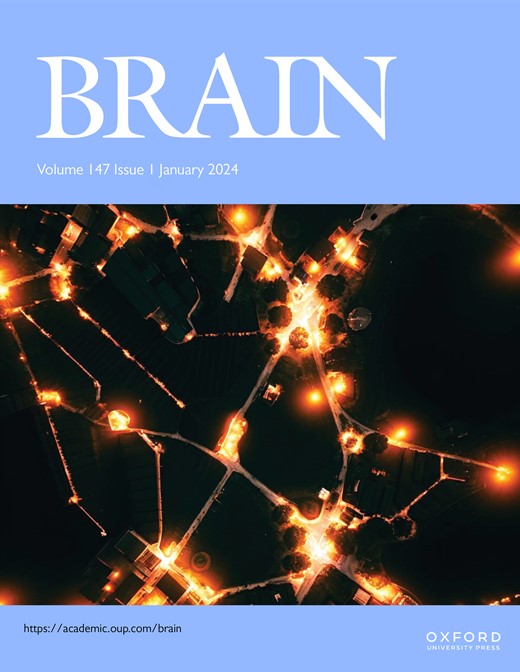定量易感性图谱揭示了路易体痴呆亚型之间的差异。
IF 11.7
1区 医学
Q1 CLINICAL NEUROLOGY
引用次数: 0
摘要
路易体痴呆(DLB)和帕金森病痴呆(PDD)是路易体痴呆的亚型,被认为是一种疾病谱系的两端。然而,传统的MRI神经成像主要集中在灰质体积和厚度上,未能确定两者之间的潜在过程是否不同。了解这些差异可以开发出靶向治疗和针对亚型的治疗方法。我们应用定量易感性制图(QSM),一种对组织铁敏感的先进神经成像技术,来检查这些路易体痴呆亚型之间组织组成的差异。我们对66例路易体痴呆患者(45例DLB; 21例PDD)进行了体素分析和感兴趣区域分析,比较了QSM值;86名认知正常的帕金森病患者(PD-NC)和37名健康对照者。我们还评估了路易体痴呆患者的QSM值与认知表现和总体疾病严重程度之间的关系。我们发现,与认知正常的PD患者相比,路易体痴呆患者在广泛的大脑区域具有更高的QSM值;PDD患者在许多大脑区域的QSM值都高于DLB患者。此外,我们发现QSM值与路易体痴呆患者的总体疾病严重程度呈正相关,QSM值使用运动障碍协会统一帕金森病评定量表测量,在右侧丘脑、左侧白质、双侧黑质、双侧额叶中部、颞叶和外侧枕叶、右侧中央前皮层和额上皮层。在兴趣区分析中,我们发现PDD患者的QSM值高于认知正常的PD患者和对照组的网状黑质。我们的研究结果表明,路易体痴呆亚型之间的神经生物学差异可以通过利用QSM对组织成分的敏感性来检测。基于此,在临床和临床试验中,DLB和PDD可以被视为不同的疾病,并且可能对不同的治疗产生反应。我们发现,QSM值与现实世界中路易体痴呆总体疾病严重程度的测量相关,这表明它有潜力作为路易体痴呆干预临床试验的成像生物标志物。本文章由计算机程序翻译,如有差异,请以英文原文为准。
Quantitative susceptibility mapping reveals differences between subtypes of Lewy body dementia.
Dementia with Lewy bodies (DLB) and Parkinson's disease dementia (PDD) are subtypes of Lewy body dementia, and are considered two ends of a disease spectrum. However, conventional MRI neuroimaging, mainly focussed on grey matter volume and thickness, has failed to establish whether underlying processes differ between them. Understanding these differences could enable targeted and subtype-specific treatments to be developed. We applied quantitative susceptibility mapping (QSM), an advanced neuroimaging technique sensitive to tissue iron, to examine differences in tissue composition between these Lewy body dementia subtypes. We performed both voxel-wise and region of interest analyses to compare QSM values in 66 people with Lewy body dementia (45 DLB; 21 PDD); 86 people with Parkinson's disease with normal cognition (PD-NC) and 37 healthy controls. We also assessed relationships between QSM values and measures of both cognitive performance and overall disease severity in people with Lewy body dementia. We found that people with Lewy body dementia had higher QSM values in widespread brain regions, compared with cognitively-normal people with PD; and that people with PDD had higher QSM values across many brain regions, compared with people with DLB. Further, we showed a positive relationship between QSM values and overall disease severity, measured using the Movement Disorders Society Unified Parkinson's disease Rating Scale in people with Lewy body dementia, in right thalamus, left pallidum, bilateral substantia nigra, bilateral middle frontal, temporal and lateral occipital lobes, right precentral and superior frontal cortices. In a region of interest analysis, we showed that people with PDD had higher QSM values than cognitively-normal people with PD and controls in the substantia nigra pars reticulata. Our findings indicate neurobiological differences between subtypes of Lewy body dementia, that can be detected by exploiting QSM's sensitivity to tissue composition. Based on this, DLB and PDD could be considered as distinct conditions in the clinic and in clinical trials, and may respond to different treatments. Our finding that QSM values relate to real world measures of overall disease severity in Lewy body dementia indicates its potential as an imaging biomarker for clinical trials of Lewy body dementia interventions.
求助全文
通过发布文献求助,成功后即可免费获取论文全文。
去求助
来源期刊

Brain
医学-临床神经学
CiteScore
20.30
自引率
4.10%
发文量
458
审稿时长
3-6 weeks
期刊介绍:
Brain, a journal focused on clinical neurology and translational neuroscience, has been publishing landmark papers since 1878. The journal aims to expand its scope by including studies that shed light on disease mechanisms and conducting innovative clinical trials for brain disorders. With a wide range of topics covered, the Editorial Board represents the international readership and diverse coverage of the journal. Accepted articles are promptly posted online, typically within a few weeks of acceptance. As of 2022, Brain holds an impressive impact factor of 14.5, according to the Journal Citation Reports.
 求助内容:
求助内容: 应助结果提醒方式:
应助结果提醒方式:


